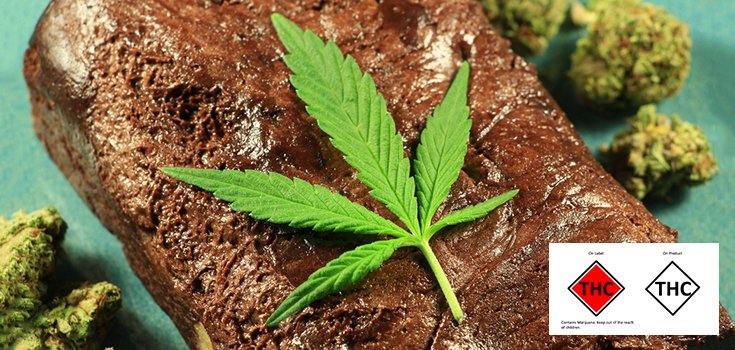Here’s Why Labels are Going on Marijuana Edibles in Colorado

As of October 1, edible marijuana products sold in Colorado must be labeled with a diamond-shaped stamp and the letters THC, both on the packaging and on the products themselves. [1]

The rule referencing the psychoactive ingredient in marijuana was added after complaints rolled in about the similarities between the pot-based treats and regular candies and baked goods.
This new “universal symbol” gives edibles a distinct look even outside of their packaging. This means that teens will have a harder time sneaking pot brownies and candies into school, and parents will be able to spot them without smelling them or interrogating their bleary-eyed kids.
It’s all part of a slew of stringent labeling and packaging rules that also include childproof zippers and lids, alongside warnings that the products should be kept out of children’s reach, and that they should not be consumed by women who are pregnant or nursing or partaken of before driving a car.
State Rep. Jonathan Singer, a Democrat who sponsored the law requiring stamped edibles, said:
“We want to ensure that people genuinely know the difference between a Duncan Hines brownie and a marijuana brownie, just by looking at it.”
There are no set statistics when it comes to how many children or adults accidentally consume marijuana. However, a study published this year tracing admissions at Children’s Hospital Colorado (CHC) found that more kids were treated for accidental pot ingestion after legalization from 1.2 per 100,000 population 2 years prior to legalization to 2.3 per 100,000 population 2 years after legalization.

Accidental pot ingestion is rare, though. CHC reports that 81 children were treated for accidental marijuana ingestion between 2009 and 2015. The authors of the study placed the blame for these accidents on “poor child supervision or product storage.”
Just 8 children were admitted to CHC between 2005 and 2013 for marijuana consumption. Marijuana was legalized in the state in 2012, but recreational sales had not yet started during this time period. [2]
By comparison, 9 children between the ages of 3 and 7 were admitted to the hospital in the 1st half of 2016 for marijuana consumption.
Read: Unintentional Pot Exposure in Colorado Has Increased 150% Since 2014
Said Dr. Michael DiStefano, a pediatric emergency medicine physician:
“They pick up [what they think is] a Swedish Fish and it looks like a gummy candy, and they eat it without knowing that there’s marijuana in the product.” [3]
He added:
“We’ve admitted kids who have ingested so much marijuana that they needed to be on a ventilator to help support their respiratory system.”
The law was passed more than a year ago, but is only going into effect now because of problems implementing it. None of the other states where weed is legal have contemplated a universal symbol requirement for marijuana products themselves, as opposed to the packaging. [1]
Part of the problem is that it’s not easy to stamp certain products, like granola, marijuana-infused sodas, or dissolvable powders. In those cases, Colorado settled for packaging rules that require sodas be in small single-serve bottles, for example.
The new rules also establish equivalency standards for the amount of THC in raw marijuana in “flower” form and the amount in retail marijuana products. A Colorado House bill limits dispensaries to selling up to an ounce of pot at a time per customer. [2]
Jim Burack, the director of the Colorado Department of Revenue’s Marijuana Enforcement Division, said:
“The No. 1 goal here: It’s about public safety, it’s about public health, and, above all, it’s sensitive to the risk this poses to children.” [2]
Sources:
[1] Associated Press
[2] Business Insider
[3] CBC
